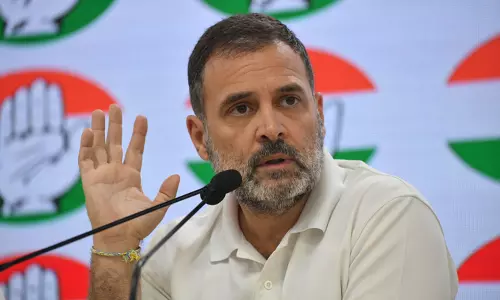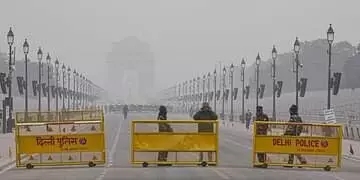
Intensifying cold wave; frigid winds whip plains in north India
text_fieldsNew Delhi: On Sunday, frosty winds battered the plains of north and northwest India, causing minimum temperatures in several places to drop to the range of 3 to 5 degrees Celsius. Up until Thursday, when western disturbances start to offer some relief, the temperature is set to drop even further.
The lowest minimum temperature over the northwest Indian plains was reported at Fatehpur in Rajasthan's Sikar district, which was minus 4.7 degrees Celsius. At minus one degree Celsius, Faridkot in Punjab shivered.
The Met Office said cold wave to severe cold wave conditions prevailed in parts of Punjab, Rajasthan, Haryana, Delhi and west Madhya Pradesh on Sunday.
Many parts of northwest and southeast Rajasthan recorded a minimum temperature in the range of 1 to 3 degrees Celsius.
Parts of Punjab, Haryana, Delhi and southwest Uttar Pradesh recorded their minimum temperature in the range of 3 to 5 degrees Celsius, it said.
Churu, located near the Thar desert, recorded the season's lowest minimum temperature of minus 2.5 degrees Celsius, according to the data available on the India Meteorological Department (IMD) website.
The mercury fell to 4.7 degrees Celsius at the Safdarjung Observatory, Delhi's primary weather station.
A cold wave saw the minimum temperature drop to 2.6 degrees Celsius at Jafarpur, 3.8 degrees Celsius at Lodhi Road, 3 degrees Celsius at Ayanagar, and 3.2 degrees Celsius at Ridge in the national capital.
The data available on the IMD's website showed that the Ujwa automatic weather station (AWS) in southwest Delhi logged a minimum temperature of minus 0.1 degrees Celsius. However, a senior IMD official said the AWS "is not working".
Delhi saw an intense cold wave spell from January 5 to January 9, the second longest in the month in a decade, according to the IMD data. It has also recorded over 50 hours of dense fog this month so far, which is the highest since 2019.
In Punjab, Amritsar recorded a minimum of 1.6 degrees Celsius. Ludhiana, Patiala, Pathankot, Bathinda and Gurdaspur experienced cold weather conditions at 4.9, 4.2, 8, 1 and 3.7 degrees Celsius respectively.
Union Territory Chandigarh, the common capital of Punjab and Haryana, recorded 6.7 degrees Celsius.
Minimum temperatures have fallen by 4-7 degrees Celsius over Punjab, Haryana, Delhi, east Rajasthan, west Uttar Pradesh and northwest Madhya Pradesh, the IMD said in a statement, adding there was no significant change in the remaining parts of northwest India.
The weather bureau said minimum temperatures are likely to fall further by about 2 degrees Celsius over many parts of northwest and central India till January 17-18 and cold wave to severe cold wave conditions are very likely over many parts of Rajasthan, Punjab and Haryana, and Delhi during this period.
"Ground Frost likely at isolated places over Himachal Pradesh, Punjab, Haryana and Rajasthan from January 16 to 18," it said.
Night temperatures in most places of Kashmir settled below the freezing point even as the weather office has forecast a further dip in the minimum temperature over the next few days in view of dry weather Srinagar recorded a low of minus 0.6 degrees Celsius on Saturday night - half a degree down from the night before, they said.
The minimum in Kupwara, a frontier district, settled at minus 1.3 degrees Celsius, the officials said.
Pahalgam in Anantnag district registered a low of minus 10.9 degrees Celsius -- down five degrees Celsius from a night earlier. It was the coldest recorded place in Jammu and Kashmir.
The IMD said minimum temperatures will gradually rise by 3 to 5 degrees Celsius from January 18 to January 20 under the influence of a western disturbance.
When a western disturbance -- a weather system characterised by warm moist winds from the Middle East -- approaches a region, the wind direction changes. The chilly northwesterly winds from the mountains stop blowing, leading to an increase in temperatures.
Weather will remain mainly dry across J-K till January 18. Fresh western disturbances are also likely to affect J-K from January 19 to 25. Light to moderate rain or snow is likely between January 23 and 24, it said.
Large parts of north and northwest India recorded below-normal maximum and minimum temperatures till January 10-11. This was due to a layer of dense fog that persisted over the Indo-Gangetic plains during the period and a large gap between two western disturbances, which meant frosty winds from the snow-clad mountains blew in for a longer-than-usual period, according to meteorologists.
In the plains, a cold wave is declared if the minimum temperature dips to 4 degrees Celsius or when it is 10 degrees Celsius and 4.5 notches below normal.
A severe cold wave is when the minimum temperature dips to 2 degrees Celsius or the departure from the normal limits is by more than 6.4 notches. A cold day is when the minimum temperature is less than or equal to 10 degrees Celsius and the maximum temperature is at least 4.5 notches below normal. A severe cold day is when the maximum temperature is at least 6.5 notches below normal.
With PTI inputs
























